Solved Examples
1. An electron beam has an aperture 1.0 mm2. A total of 6.0 × 1016 electrons go through any perpendicular cross section per second.Find (a) the current and (b) the current density in the beam.
Sol.(a) The total charge crossing a perpendicular cross–section in one second is
q = ne
= 6.0 × 1016 × 1.6 × 10–19 C
= 9.6 × 10–3 C.
The current is
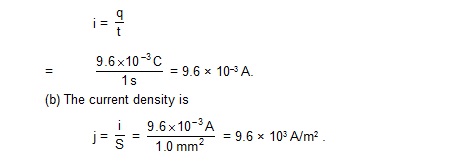
Ans. (a) 9.6 × 10–3 A. (b) 9.6 × 103 A/m2
2. Calculate the drift speed of the electrons when 1 A of current exists in a copper wire of cross-section 2 mm2. The number of free electrons in 1 cm3 of copper is 8.5 × 1022.
Sol. We have
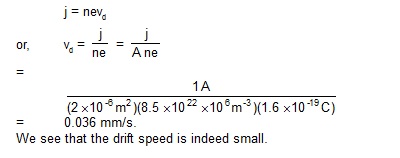
Ans. 0.036 mm/s.
3. Calculate the resistance of an aluminium wire of length 50 cm and cross-sectional area 2.0 mm2. The resistivity of sluminium is r = 2.6 × 10–8ohm - m.

We arrived at Ohm's (equation 32.6 or 32.8) by making several assumptions about the existance and behaviour of the free electrons.These assumptions are not valid for semiconductors, insulators,solutions etc. Ohm's law cannot be applied in such cases.
Ans. 0.0065 ohm
4. A resistor develops 400 J of thermal energy in 10 s when a current of 2 A is passed through if. (a) Find its resitance. (b) If the current is increased to 4 A, what will be the energy developedin 20 s.

5. A battery of emf 2.0 V and interial resistance 0.50 W supplies a current of 100 mA. Find (a) the potential difference across the terminals of the battery and (b) the thermal energy developed in the battery in 10 s.
Sol. The situation is the same as that shown in figure.
(a) The potential difference across the terminals is
VA – VB = (VA – VC) – (VB – VC)
= e – ir
= 2.0 V – (0.100 A) (0.50 ohm) = 1.95 V.
(b) The thermal energy developed in the battery is
U = i2rt = (0.100 A)2 (0.50 ohm) (10 s) = 0.50 J,
Ans. (a) 1.95 V (b) 0.05 J
6. Find the equivalent resistance of the network shown in figure between the points A and B.

Sol. The 10 ohm resistor and the 30 ohm resistor are connected in parallel. The equivalent resistance between A and C is
R1 = (10 ohm)(30 ohm)/10ohm+30ohm = 7.5 W.
This is connected with 2.5 ohm in series. The equivalent resistance between A and B is 7.5 ohm + 2.5 ohm = 10 ohm
Ans. 10 ohm
7. Find the value of R in figure so that there is no current in the 50 W resistor.
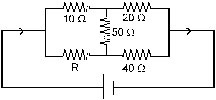
Sol. This is a Wheatstone bridge with the galvanometer replaced by the 50 W resistor. There will be no current in the 50 W resistor if the bridge is balanced.
In this case,
10ohm/20ohm = R/40ohm
or R = 20 ohm
Ans. R = 20 ohm
8. The ammeter shown in figure consists of a 480 W coil connected in parallel to a 20 W shunt. Find the reading of the ammeter.

Sol. The equivalent resistance of the ammeter is
(480ohm)(20ohm)/480ohm+20ohm = 19.2 ohm
The equivalent resistance of the circuit is
140.8 + 19.2 ohm = 160 ohm
The current is i =20V/160ohm = 0.125 A.
This current goes through the ammeter and hence the reading of the ammeter is 0.125 A.
Ans. 0.125 A.
Questions for Short answer
1. Suppose you have three resistors each of value 30 ohm. List all the different resistances you can obtain using them.
2. A proton beam is going from east to west. Is there an electric current ? If yes, in what direction ?
3. In an electrolyte, the positive ions move from left to right and the negative ions from right to left. Is there a net current ? If yes, in what direction ?
4. In a TV tube, the electrons are accelerated from the rear to the front. What is the direction of the current ?
![]()
6. One of your friends argues that he has read in previous chapters that there can be no electric field inside a conductor. And hence there can be no current through it. What is the fallacy in this argument ?
7. When a current is established in a wire, the free electrons drift in the direction opposite to the current. Does the number of free electrons in the wire continuously decrease ?
8. A fan with copper winding in its motor consumes less power as compared to an otherwise similar fan having aluminium winding. Explain.
9. The thermal energy developed in a current–carrying resistor is given by U = i2Rt and also by U = Vit. Should we say that U is proportional to i2 or to i ?
10. Consider a circuit containing an ideal battery connected to a resistor. Do "work done by the battery" and "the thermal energy developed" represent two names of the same physical quantity ?
11. Is work done by a battery always equal to the thermal energy developed in electrical circuits ? What happens if a capacitor is connected in the circuit ?
12. A nonideal battery is connected to a resistor. Is work done by the battery equal to the thermal energy developed in the resistor ? Does your answer change if the battery is ideal ?
13. Sometimes it is said that "heat is developed" in a resistance when there is an electric current in it. Recall that heat is defined as the energy being transferred due to the temperature difference. Is the statement under quotes technically correct ?
14. We often say "a current is going through the wire". What goes through the wire, the charge or the current ?
15. Would you prefer a voltmeter or a potentiometer to measure the emf of a battery ?
16. Does a conductor become charged when a current is passed through it ?
17. Can the potential difference across a battery be greater than its emf ?
Objective - I
1. A metallic resistor is connected across a battery. If the number of collisions of the free electrons with the lattice is somehow decreased in the resistor (for example, by cooling it), the current will
(A) increase (B) decrease (C) remain constant (D) become zero

3. The product of resistivity and conductivity of a cylindrical conductor depends on
(A) temperature (B) material (C) area of cross-section (D) none of these
4. As the temperature of a metallic resistor is increased, the product of its resistivity and conductivity
(A) increases (B) decreases (C*) remains constant (D) may increase or decrease
5. In an electric circuit containing a bettery, the charge (assumed positive) inside the battery
(A) always goes from the positive terminal to the negative terminal
(B) may go from the positive terminal to the negative terminal
(C) always goes from the negative terminal to the positive terminal
(D) does not move.
6. A resistor of resistance R is connected to an ideal battery. If the value of R is decreased, the power dissipated in the resistor will -
(A) increase (B) decrease (C) remain unchanged
7. A current passes through a resistor. Let K1 and K2 represent the average kinetic energy of the conduction electrons and the metal ions respectively.
(A) K1 < K2 (B) K1 = K2 (C) K1 > K2 (D) Any of these three may occur
8. Two resistance R and 2R are connected in series in an electric circuit.The thermal energy developed in R and 2R are in the ratio
(A) 1 : 2 (B) 2 : 1 (C) 1 : 4 (D) 4 : 1
9. Two resistance R and 2R are connected in parallel in an electric circuit. The thermal energy developed in R and 2R are in the ratio
(A) 1 : 2 (B*) 2 : 1 (C) 1 : 4 (D) 4 : 1
10. A uniform wire of resistance 50W is cut into 5 equal parts. These parts are now connected in parallel.The equivalent resistance of the combination is
(A) 2ohm (B) 10ohm (C) 250ohm (D) 6250ohm
11. Consider the following two statements :
(a) Kirchhoff’s junction law follows from conservation of charge.
(b) Kirchhoff’s loop law follows from consevative neature of electric field.
(A) Both A and B are correct (B) A is correct but B is wrong
(C) B is correct but A is wrong (D) Both A and B are wrong
12. Two non-ideal batteries are connected in series. Consider the following statements:
(a) The equivalent emf is larger either of the two emfs.
(b) The equivalent internal resistance is smaller than either of the two internal resistance.
(A) Each of A and B is correct (B) A is correct but B is wrong
(C) B is correct but A is wrong (D) Each of A and B is wrong.
13. Two non-ideal batteries are connected in parallel. Consider the following statements
(a) The equivalent emf is smaller than either of the two emfs.
(b) The equivalent internal resistance is smaller than either of the two internal resistance.
(A) Both a and b are correct (B) a is correct but b is wrong
(C) b is correct but a is wrong (D) Each of a and b is wrong
14. The net resistnace of an ammeter should be small to ensure that
(A) it does not get overheated (B) it does not draw excessive current
(C) it can measure large currents (D) it does not appreciably change the current to be measured.
15. The net resistance of a voltmeter should be large to ensure that
(A) it does not get overheated (B) it does not draw excessive current
(C) it can measure large potential differences
(D) it does not appreciably change the potential difference to be measured.
16. Consider a capacitor-charging circuit. Let Q1 be the charge given to the capacitor in a time interval of 10 ms and Q2 be the charge given in the next time interval of 10 ms. Let 10 mC charge be deposited in a time interval t1 and the next 10mC charge is deposited in the next time interval t.
(A) Q1 > Q2, t1 > t2. (B*) Q1 > Q2, t1 < t2. (C) Q1 > Q2, t1 > t2. (D) Q1 < Q2, t1 < t2.
Objective - II
1. Electrons are emitted by a hot filament and are accelerated by an elecrtic field as shown in fig. The two stops at the left ensure that the electron beam has a uniform cross-section.
(A) The speed of the electron is more at B than at A.
(B) The electric current is from left to right
(C) The magnitude of the current is larger at B than at A.
(D) The current density is more at B than at A.
2. A capacitor with no dielectric is connected to a battery at t = 0. Condiser a point A in the connecting wires and a point B in between the plates.
(A) There is no current through A
(B) There is no current through b
(C) There is a current through A as long as the charging is not complete.
(D) There is a current through B as long the charging is not complete.
3. When no current is passed through a conductor
(A) the free electrons do not move
(B) the average speed of a free electron over a large period of time is zero
(C) the average velocity of a free electron over a large period of time is zero
(D) the average of the velocities of all the free electrons at an instant is zero
4. Which of the following quanitites do not change when a resistor connected to a battery is heated due to the current ?
(A) drift speed (B) resistivity (C) resistance (D*) number of free electrons
5. As the temperature of a conductor increases, its resistivity and conductivity change. The ratio of resistivity to conductivity
(A) increases (B) decreases (C) remains constant
(D) may increase or decrease depending on the actual temperature.
6. A current passes through a wire of nonuniform cross-section. Which of the following quantities are independent of the cross-section?
(A) the charge corssing in a given time interval (B) drift speed
(C) current density (D) free-electron density.
7. Mark out the correct options.
(A) An ammeter should have small resistance (B) An ammeter should have large resistance
(C) A voltmeter should have small rsistance (D*) A voltmeter should have large resistance

1. An electron moves in a circle of radius 10 cm with a constant speed of 4.0 × 106 m/s. Find the electric current at a point on the circle.
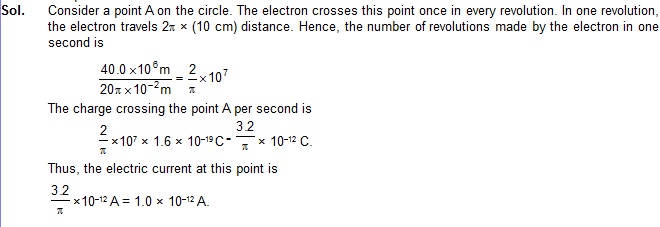
2. A current of 2.0 A exists in a wire of cross-sectional area 1.0 mm2. If each cubic metre of the wire contains 6.0 × 1028 free electrons, find the drift speed.

3. Find the resistance of a copper coil of total wire-length 10 m and area of cross-section 1.0 mm2. What would be the resistance of a similar coil of aluminium? The resitivity of copper = 1.7×10–8 W-m and that of aluminium = 2.6 × 10–8 ohm-m.
Sol. The resistance of the copper coil is

4. A parallel-area capacitor has plates of area 10 cm2 separated by a distance of 1mm. It is filled with the dielectric mica and connected to a battery of emf 6 volts. Find the leakage current through the capacitor. Resistivity of mica = 1 × 1013 ohm-m.
Sol. The resistance of the mica between the two faces is

5. Find the resistance of a hollow cylindrical conductor of length 1.0 m and inner and outer radii 1.0 mm and 2.0 mm respectively. The resistivity of the material is 2.0 × 10–8 W-m.
Sol. The area of cross-section of the conductor through which the charges will flow is

The resistance of the wire is, therefore,
![]()
6. A battery of emf 2 V and initial resistance 0.5 W is connected across a resistance 9.5 W. How many electrons cross through a cross-section of the resistance in 1 second ?
Sol. The current in the circuit is
i = 2V/9.5ohm+0.5ohm = 0.2 A.
Thus, a net transfer of 0.2 C per second takes place across any cross-section in the circuit. The number of electrons crossing the section in 1 second is therefore,
0.2C/1.6×10=19C = 0.125 × 1019 = 1.25 × 1018.
7. A battery of emf 2.0 volts and internal resistance 0.10 W is being charged with a current of 5.0 A. What is the potential difference between the terminals of the battery.
Sol.
As the battery is being charged, the current goes into the positive terminals as shown in figure.
The potential drop across the internal resistance is 5.0 A × 0.10 ohm = 0.150 V.
Hence the potential drop across the terminals will be 2.0 V + 0.50 V = 2.5 V.
8. Figure shows n batteries connected to form a circuit. The resistances denote the internal resistance of the batteries which are related to the emf’s as r1 = ki where k is a constant. The solid dots represent the terminals of the batteries. Find (a) the current through the circuit and (b) the potential difference between the terminals of the ith battery.
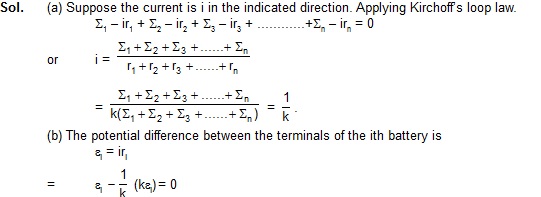
9. A copper rod of length 20 cm and cross-sectional area 2 mm2 is joined with a similar aluminum rod as shown in figure. Find the resistance of the combination between the ends. Resistivity of copper = 1.7×108 W-m and that of aluminum = 2.6 × 108 ohm-m.

or R=1.7×2.6/4.3×10-3 ohm = 1.0m ohm
10. A wire of reistance 10 W is bent to form a complete circle. Find its resistance between two diametrically opposite points.

Sol. Let ABCDA be the resistance 10 ohm. We have to calculate the resistance of this loop between the diametrically opposite point A and C. The wires ADC and ABC will have resistance 5ohm each. These two are joined in parallel between A and C. The equivalent resistance R between A and C is, therefore, given by
R = 5ohm×5ohm/5ohm+5ohm = 2.5 W.
11. Find the currents in the different resistors shown in figure.
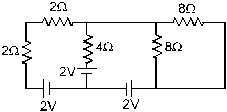
Sol. The two 2 ohm resistors are in series so that their equivalent resistance is 4ohm. The two 8ohm resistors are in paralleland their equivalent resistance is also 4 ohm.
The circuit may be redrawn as in figure. Suppose the middle 4 ohm resistor is removed. The remaining circuit in figure. It is easy to see that no current will go through any resistor. If we take the potential at b to be zero, the potential at
d will be 2 V. The potential at a dn c will also be 2V. As there is no current in the 4ohm resistors, the potential at e will also be 2V. Thus, there is no potential difference between d and e. When a 4ohm resistor is added between d and e, no urrent will be drawn into it and hence no change will occur in the remaining part of the circuit. This circuit is then the same as the given circuit. Thus, the current in all the resistors in the given circuit is zero.
12. Find the current supplied by the battery in the circuit shown in figure.

Sol. All the resistors shown in the figure are connected in parallel between the terminals of the battery. The equivalent resistance R between the terminals is, therefore given by

i = V/R = 3V/3ohm = 1A.